Minh Hoai
Can Current AI Models Count What We Mean, Not What They See? A Benchmark and Systematic Evaluation
Sep 17, 2025Abstract:Visual counting is a fundamental yet challenging task, especially when users need to count objects of a specific type in complex scenes. While recent models, including class-agnostic counting models and large vision-language models (VLMs), show promise in counting tasks, their ability to perform fine-grained, intent-driven counting remains unclear. In this paper, we introduce PairTally, a benchmark dataset specifically designed to evaluate fine-grained visual counting. Each of the 681 high-resolution images in PairTally contains two object categories, requiring models to distinguish and count based on subtle differences in shape, size, color, or semantics. The dataset includes both inter-category (distinct categories) and intra-category (closely related subcategories) settings, making it suitable for rigorous evaluation of selective counting capabilities. We benchmark a variety of state-of-the-art models, including exemplar-based methods, language-prompted models, and large VLMs. Our results show that despite recent advances, current models struggle to reliably count what users intend, especially in fine-grained and visually ambiguous cases. PairTally provides a new foundation for diagnosing and improving fine-grained visual counting systems.
DualMat: PBR Material Estimation via Coherent Dual-Path Diffusion
Aug 07, 2025Abstract:We present DualMat, a novel dual-path diffusion framework for estimating Physically Based Rendering (PBR) materials from single images under complex lighting conditions. Our approach operates in two distinct latent spaces: an albedo-optimized path leveraging pretrained visual knowledge through RGB latent space, and a material-specialized path operating in a compact latent space designed for precise metallic and roughness estimation. To ensure coherent predictions between the albedo-optimized and material-specialized paths, we introduce feature distillation during training. We employ rectified flow to enhance efficiency by reducing inference steps while maintaining quality. Our framework extends to high-resolution and multi-view inputs through patch-based estimation and cross-view attention, enabling seamless integration into image-to-3D pipelines. DualMat achieves state-of-the-art performance on both Objaverse and real-world data, significantly outperforming existing methods with up to 28% improvement in albedo estimation and 39% reduction in metallic-roughness prediction errors.
Few-shot Personalized Scanpath Prediction
Apr 07, 2025Abstract:A personalized model for scanpath prediction provides insights into the visual preferences and attention patterns of individual subjects. However, existing methods for training scanpath prediction models are data-intensive and cannot be effectively personalized to new individuals with only a few available examples. In this paper, we propose few-shot personalized scanpath prediction task (FS-PSP) and a novel method to address it, which aims to predict scanpaths for an unseen subject using minimal support data of that subject's scanpath behavior. The key to our method's adaptability is the Subject-Embedding Network (SE-Net), specifically designed to capture unique, individualized representations for each subject's scanpaths. SE-Net generates subject embeddings that effectively distinguish between subjects while minimizing variability among scanpaths from the same individual. The personalized scanpath prediction model is then conditioned on these subject embeddings to produce accurate, personalized results. Experiments on multiple eye-tracking datasets demonstrate that our method excels in FS-PSP settings and does not require any fine-tuning steps at test time. Code is available at: https://github.com/cvlab-stonybrook/few-shot-scanpath
Look Hear: Gaze Prediction for Speech-directed Human Attention
Jul 28, 2024



Abstract:For computer systems to effectively interact with humans using spoken language, they need to understand how the words being generated affect the users' moment-by-moment attention. Our study focuses on the incremental prediction of attention as a person is seeing an image and hearing a referring expression defining the object in the scene that should be fixated by gaze. To predict the gaze scanpaths in this incremental object referral task, we developed the Attention in Referral Transformer model or ART, which predicts the human fixations spurred by each word in a referring expression. ART uses a multimodal transformer encoder to jointly learn gaze behavior and its underlying grounding tasks, and an autoregressive transformer decoder to predict, for each word, a variable number of fixations based on fixation history. To train ART, we created RefCOCO-Gaze, a large-scale dataset of 19,738 human gaze scanpaths, corresponding to 2,094 unique image-expression pairs, from 220 participants performing our referral task. In our quantitative and qualitative analyses, ART not only outperforms existing methods in scanpath prediction, but also appears to capture several human attention patterns, such as waiting, scanning, and verification.
Detecting Omissions in Geographic Maps through Computer Vision
Jul 15, 2024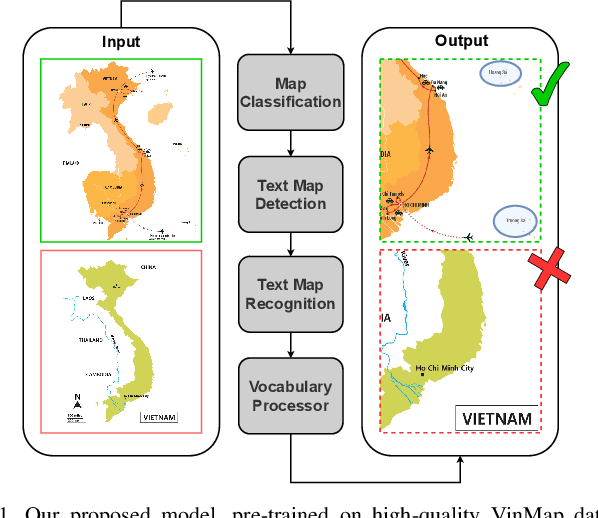
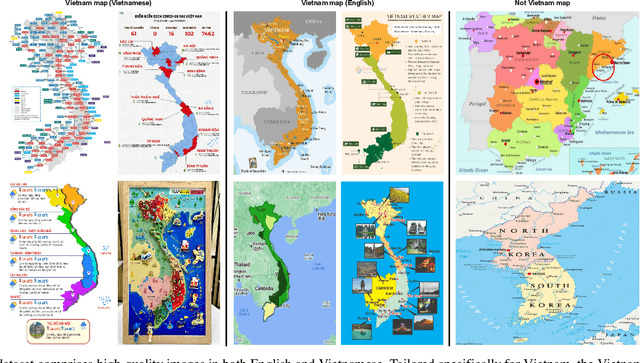
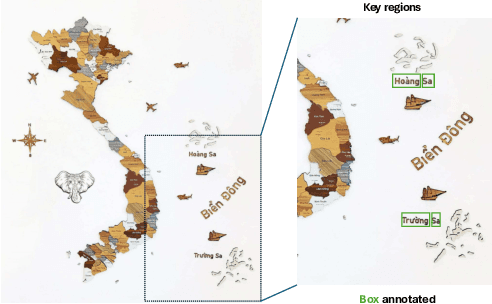
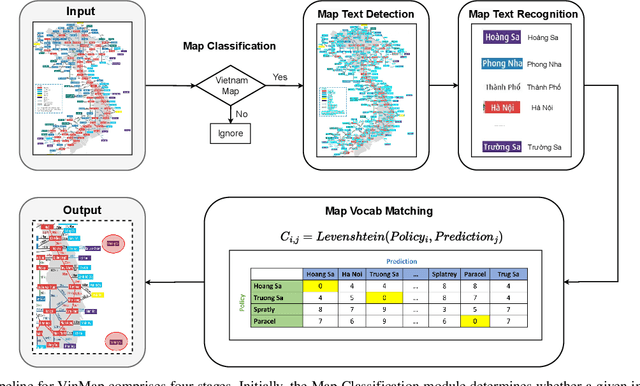
Abstract:This paper explores the application of computer vision technologies to the analysis of maps, an area with substantial historical, cultural, and political significance. Our focus is on developing and evaluating a method for automatically identifying maps that depict specific regions and feature landmarks with designated names, a task that involves complex challenges due to the diverse styles and methods used in map creation. We address three main subtasks: differentiating maps from non-maps, verifying the accuracy of the region depicted, and confirming the presence or absence of particular landmark names through advanced text recognition techniques. Our approach utilizes a Convolutional Neural Network and transfer learning to differentiate maps from non-maps, verify the accuracy of depicted regions, and confirm landmark names through advanced text recognition. We also introduce the VinMap dataset, containing annotated map images of Vietnam, to train and test our method. Experiments on this dataset demonstrate that our technique achieves F1-score of 85.51% for identifying maps excluding specific territorial landmarks. This result suggests practical utility and indicates areas for future improvement.
Diffusion-Refined VQA Annotations for Semi-Supervised Gaze Following
Jun 04, 2024Abstract:Training gaze following models requires a large number of images with gaze target coordinates annotated by human annotators, which is a laborious and inherently ambiguous process. We propose the first semi-supervised method for gaze following by introducing two novel priors to the task. We obtain the first prior using a large pretrained Visual Question Answering (VQA) model, where we compute Grad-CAM heatmaps by `prompting' the VQA model with a gaze following question. These heatmaps can be noisy and not suited for use in training. The need to refine these noisy annotations leads us to incorporate a second prior. We utilize a diffusion model trained on limited human annotations and modify the reverse sampling process to refine the Grad-CAM heatmaps. By tuning the diffusion process we achieve a trade-off between the human annotation prior and the VQA heatmap prior, which retains the useful VQA prior information while exhibiting similar properties to the training data distribution. Our method outperforms simple pseudo-annotation generation baselines on the GazeFollow image dataset. More importantly, our pseudo-annotation strategy, applied to a widely used supervised gaze following model (VAT), reduces the annotation need by 50%. Our method also performs the best on the VideoAttentionTarget dataset.
HOIST-Former: Hand-held Objects Identification, Segmentation, and Tracking in the Wild
Apr 22, 2024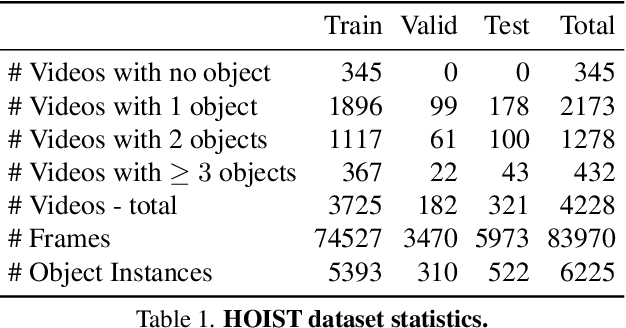
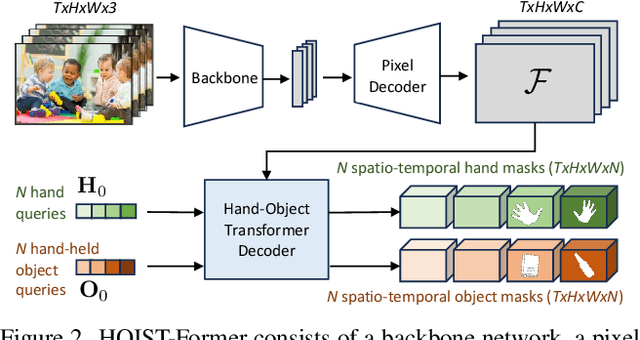
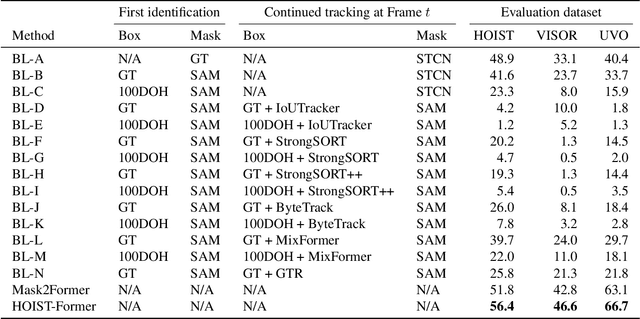

Abstract:We address the challenging task of identifying, segmenting, and tracking hand-held objects, which is crucial for applications such as human action segmentation and performance evaluation. This task is particularly challenging due to heavy occlusion, rapid motion, and the transitory nature of objects being hand-held, where an object may be held, released, and subsequently picked up again. To tackle these challenges, we have developed a novel transformer-based architecture called HOIST-Former. HOIST-Former is adept at spatially and temporally segmenting hands and objects by iteratively pooling features from each other, ensuring that the processes of identification, segmentation, and tracking of hand-held objects depend on the hands' positions and their contextual appearance. We further refine HOIST-Former with a contact loss that focuses on areas where hands are in contact with objects. Moreover, we also contribute an in-the-wild video dataset called HOIST, which comprises 4,125 videos complete with bounding boxes, segmentation masks, and tracking IDs for hand-held objects. Through experiments on the HOIST dataset and two additional public datasets, we demonstrate the efficacy of HOIST-Former in segmenting and tracking hand-held objects.
Driver Attention Tracking and Analysis
Apr 11, 2024



Abstract:We propose a novel method to estimate a driver's points-of-gaze using a pair of ordinary cameras mounted on the windshield and dashboard of a car. This is a challenging problem due to the dynamics of traffic environments with 3D scenes of unknown depths. This problem is further complicated by the volatile distance between the driver and the camera system. To tackle these challenges, we develop a novel convolutional network that simultaneously analyzes the image of the scene and the image of the driver's face. This network has a camera calibration module that can compute an embedding vector that represents the spatial configuration between the driver and the camera system. This calibration module improves the overall network's performance, which can be jointly trained end to end. We also address the lack of annotated data for training and evaluation by introducing a large-scale driving dataset with point-of-gaze annotations. This is an in situ dataset of real driving sessions in an urban city, containing synchronized images of the driving scene as well as the face and gaze of the driver. Experiments on this dataset show that the proposed method outperforms various baseline methods, having the mean prediction error of 29.69 pixels, which is relatively small compared to the $1280{\times}720$ resolution of the scene camera.
Blur2Blur: Blur Conversion for Unsupervised Image Deblurring on Unknown Domains
Mar 24, 2024

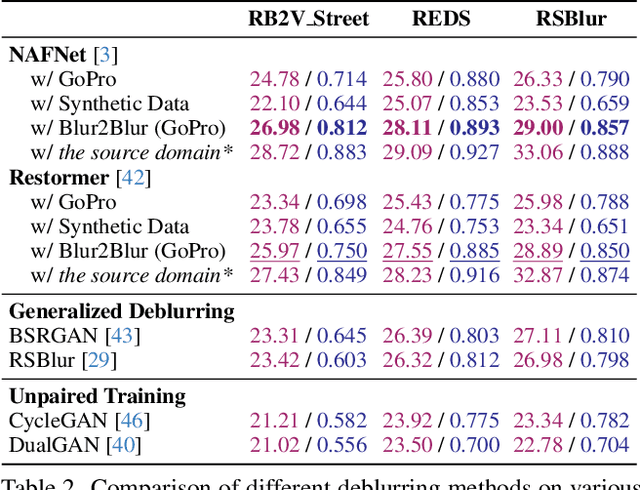
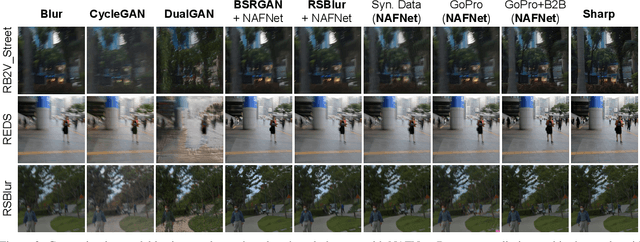
Abstract:This paper presents an innovative framework designed to train an image deblurring algorithm tailored to a specific camera device. This algorithm works by transforming a blurry input image, which is challenging to deblur, into another blurry image that is more amenable to deblurring. The transformation process, from one blurry state to another, leverages unpaired data consisting of sharp and blurry images captured by the target camera device. Learning this blur-to-blur transformation is inherently simpler than direct blur-to-sharp conversion, as it primarily involves modifying blur patterns rather than the intricate task of reconstructing fine image details. The efficacy of the proposed approach has been demonstrated through comprehensive experiments on various benchmarks, where it significantly outperforms state-of-the-art methods both quantitatively and qualitatively. Our code and data are available at https://zero1778.github.io/blur2blur/
HanDiffuser: Text-to-Image Generation With Realistic Hand Appearances
Mar 04, 2024



Abstract:Text-to-image generative models can generate high-quality humans, but realism is lost when generating hands. Common artifacts include irregular hand poses, shapes, incorrect numbers of fingers, and physically implausible finger orientations. To generate images with realistic hands, we propose a novel diffusion-based architecture called HanDiffuser that achieves realism by injecting hand embeddings in the generative process. HanDiffuser consists of two components: a Text-to-Hand-Params diffusion model to generate SMPL-Body and MANO-Hand parameters from input text prompts, and a Text-Guided Hand-Params-to-Image diffusion model to synthesize images by conditioning on the prompts and hand parameters generated by the previous component. We incorporate multiple aspects of hand representation, including 3D shapes and joint-level finger positions, orientations and articulations, for robust learning and reliable performance during inference. We conduct extensive quantitative and qualitative experiments and perform user studies to demonstrate the efficacy of our method in generating images with high-quality hands.
 Add to Chrome
Add to Chrome Add to Firefox
Add to Firefox Add to Edge
Add to Edge